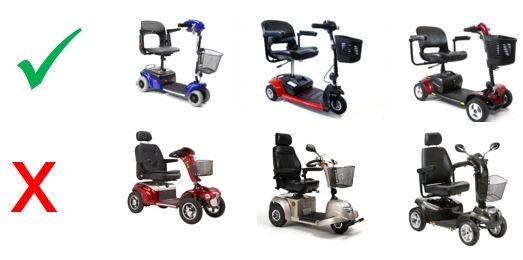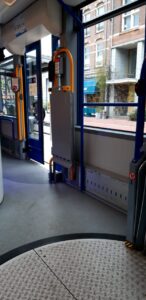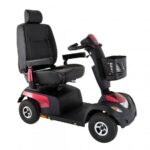Accessibility of trams in Amsterdam: In Amsterdam, if you’re not cycling, you’re likely to be taking the tram. It’s one of the most convenient, fast, and safe modes of transport in the city. Trams depart regularly from Amsterdam Central Station, connecting you to various neighborhoods and popular destinations.
GVB, the city’s public transport company, is making significant strides in improving accessibility for people with disabilities, those with limited mobility, parents with baby buggies, and travelers with heavy luggage. Newer trams and buses are increasingly designed with street-level entrances and space for wheelchairs and baby buggies, ensuring easier access for all passengers.
However, older trams are less accessible, particularly for people using wheelchairs or requiring additional assistance. If an older tram is accessible, it will feature the ITS symbol (International Accessibility Symbol) at the entrance, indicating it meets basic accessibility standards.
This ongoing effort by GVB to enhance accessibility means that Amsterdam’s public transport is becoming more inclusive, offering greater convenience for everyone, no matter their mobility needs.
Accessiblity of trams in Amsterdam
The older type trams
In Amsterdam you will notice different kind of trams. The older type trams are not all accessible. If they are accessible it has the pink ITS symbol at the accessible entrance. The non-accessible trams have high entrances with stairs and have narrow paths inside the tram. Some are also multileveled inside. The entrances and exits do not fit the platform level of the tram stops. The GVB developed maps and schedules which indicate the accessible stops and accessible tram routes. Currently the maps are only available online in Dutch but when you arrive in Amsterdam you can pick up an English version at the GVB service desk, which is situated opposite to the South side of the station.
The newer type trams
The new trams are increasingly accessible. The entrances are wider and low without stairs. The accessible entrance is situated in the middle of the tram and has a special spot for a wheelchair, walker or stroller. The spot is marked with a sign on the inside of the tram. Wheelchairs are prioritized over prams. Apart for a wheelchair accessible spot, the trams also have seats for people who are less mobile. The trams are on one level (not multileveled) and also offer accessibility service for people with hearing or sight impairments. The next tram stop is shown on the multiple displays in the tram and is broadcasted. The stop buttons have braille.
Maps
The network map is displayed in the tram and at the tram stops. It is available online and at the GVB Tickets and Info desk. The network map indicates which tram stops are accessible.
- The tram stops that have accessible platforms on both sides of the tram track show a black dot;
- The tram stops that have an accessible platform on one side of the tram track show a half black dot;
- The tram stops that have no accessible platform show a white dot.
Check the interactive map of Amsterdam’s tram network here.
The time tables in the tram stops also show which platforms of that route are accessible. If a certain time on the time schedule shows a red A behind it, this means that an old tram is used for this route and it’s most probably not wheelchair accessible. This webpage on the GVB website explains about the regulations for bicycles, strollers and wheelchair users on public transport.
Departure times
The majority of trams go every 10 to 15 minutes. In the evenings the trams go less often and in the weekends the schedule is different. Most trams run from 07:00 AM until between 12:30 AM.
How to purchase tickets
While in Amsterdam
When in Amsterdam, you can purchase your ticket at the GVB Ticket Desk at Amsterdam Central Station. You can also buy it in the tram with the conductor. The majority of hotels also sell GVB tickest.
Purchase in advance
If you stay for more than 3 days, it can be convenient and economic to buy the GVB ticket for multiple days in advance. You can purchase your GVB ticket on Tiqets. You will receive a digital voucher which you can swap for the actual GVB-card in the Connexxion bus at Schiphol Airport, at the GVB office at Amsterdam Central Station or stations Zuid, Noord or Bijlmer-Arena.
OV-chipkaart
If you plan on returning to Amsterdam more often, you can also decide to purchase an OV-Chipcard. This card allows you check-in and check-out in the trams, at the metro stations and train stations. It can take you anywhere in the country! You can charge this card with an amount and the actual amount of the journey will be taken of the card.
Entrance
The most recent model of trams are situated on a single level. The entrance is centrally positioned and its accessibility is denoted by a sticker featuring a wheelchair icon. This entry point is designed for use by individuals with wheelchairs, mobility scooters, and strollers alike. Inside the tram, there’s a designated seat accessible for wheelchair users, along with reserved seating for individuals with limited mobility. Additionally, there’s an auditory announcement system for stops, and the route is displayed in real-time on various monitors. GVB’s website outlines boarding priorities: wheelchair users are given precedence over those with scooters or strollers, while individuals with mobility scooters are prioritized over those with strollers.
Older Generation Trams:
Amsterdam still operates some older model trams, not all of which are accessible (those that are feature a pink ITS symbol). These older trams are built across multiple levels and have entrance steps.
Check-in and check-out:
Remember to always check-in and check-out with your transport card every time you travel, even for a simple change of vehicle. At the entrances and exits there is a digital reader on which you can pass your card. Entry: If successful, a green light will turn on and the digital reader will emit a beep. Exit: you will always have the green light but two beeps.
Tram stop accessibility:
Do you want to see if a stop is accessible? Consult the dedicated GVB page by clicking here.
Mobility scooters
Electric scooters must have these maximum measurements: 120cm long, 70cm wide and 109cm high. Vehicles that exceed these dimensions will not be accepted inside the tram. Here on the left you can find images of allowed and non-admitted scooters, according to the GVB website.

Safety
According to the advice of the transport company, the traveler is advised to park the wheelchair or mobility scooter with the backrest facing the direction of travel. In an emergency, this should be the safest way.
Indications of the driver/conductor:
Travelers should follow the directions of the driver and / or conductor. They reserve the right to refuse access to a traveler with a wheelchair, mobility scooter, bicycle or pushchair in order to safeguard the safety of travelers.
Plan your trip
On the official GVB website you can plan your trip by entering the starting point and the arrival point. With the “additional option” you can select travel suggestions that take into account only accessible stops (by checking the “toegankelijk plannen” box).
Maps
Almost all tram stops have a map showing the line’s connections within the city. A paper map can be requested at the GVB ticket offices and information desk. It is also possible to consult the digital map directly from the company’s website by clicking here.

Would you like to enhance your trip to the Netherlands?
Enhance your trip to the Netherlands with our tailored services! From accessible tours and mobility equipment rentals to convenient hotel bookings, we cater to all your travel needs. Experience the beauty and culture of the Netherlands with options designed for your comfort and accessibility. Explore our offerings today and make the most of your visit!
about the author

Silvia Causin is a passionate expert in accessible travel, committed to making travel more inclusive for everyone. She shares valuable insights on how to navigate the world with ease, comfort, and confidence.

Experience the best of the Netherlands with our thoughtfully designed accessible tours. Enjoy cultural attractions, scenic sights, and guided explorations that cater to your mobility needs, ensuring an enriching experience for everyone.

Find the perfect accommodation with our hotel booking service. We offer a selection of accessible hotels that prioritize your comfort, ensuring a restful stay as you explore the beauty of the Netherlands.

Make your journey easier with our mobility equipment rental service. From wheelchairs to scooters, we provide high-quality equipment to help you navigate the Netherlands comfortably and confidently.
